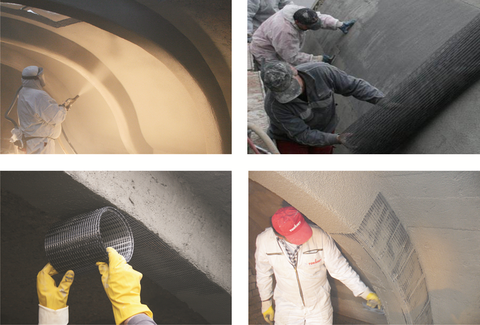Textile concrete

Various high-performance materials like aramid, glass, basalt, or carbon fibers, and hybrid materials for further processing of reinforcements in construction
Textile concrete is an innovative composite material consisting of concrete and textile reinforcements, which is also referred to as textile-reinforced concrete. It is suitable for the production of new and the reinforcement or renovation of existing components or buildings. The concrete is very finely grained and strong in comparison to average concrete. The tensile forces to be absorbed by the component are transferred by means of textile reinforcements made from high-performance materials in the form of tailor-made and coated grid-like structures, such as non-crimp fabrics. Fiber materials with excellent structural-mechanical potential are used, including alkali-resistant glass, or carbon. The textiles are prepared for the application in textile concrete by technical and chemical treatments.

Carbon fiber reinforcement structure made on a modern multiaxial warp-knitting machine with integrated application and drying module
The great advantages of textile concrete are in its vastly improved performance with regard to structure-mechanical potential, combined with lower weight in comparison to conventional rebars, and the immunity of the high-performance fiber materials to corrosion. The concrete cover of several centimeters necessary in ferroconcrete can be minimized, allowing the realization of very lightweight and slender buildings with previously unknown filigree characteristics and aesthetics.

Reinforcement structures for the reinforcement of existing buildings, exemplified by a concrete shell
The revolution of the construction industry is in full swing, and the next generation of buildings will be reinforced with carbon textiles. Textile reinforcements have been established as a reliable reinforcement component and were first approved for use as a construction material for the reinforcement of textile concrete edifices by the German Center of Competence for Construction (DiBT) in 2014. In co-operation with our partners at the C³ (Carbon Concrete Composites) research initiative, and with the ITM’s textile-technical know-how, the foundation is created for these innovative reinforcement structures. Constructions made of textile concrete help us reduce resource and energy consumption, increase the durability and safety of our building constructions, and raise awareness for ecological and economic efficiency and sustainability in the area of construction. The change to the material combination of carbon and concrete can deliver more than the sum of its two parts, and has given rise to a new kind of design, construction and life.
Contact person:
 © Mirko Krziwon
© Mirko Krziwon
Mr Dr.-Ing. Danny Friese
Leader Multiaxial warp knitting and robotics for composites
Send encrypted email via the SecureMail portal (for TUD external users only).
Visiting address:
Breitscheidstr. 78, House D, Room 1.1.13
01237 Dresden
